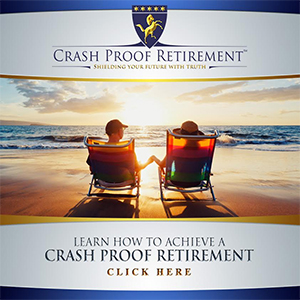Recently, noted retirement specialist Phil Cannella,
founder of First Senior Financial Group and host of The Crash Proof Retirement Show™, spoke with a Philadelphia-area reporter on numerous topics that are of vital interest to retirees. In this series we’ll be presenting excerpts from those talks. The current passage is on “too much safety.”
Q: You say there’s such a thing as “too much safety.” I think you’re being facetious, but what do you mean by that?
Phil Cannella: You’re right, I’m being partly facetious, because total safety is, of course, the goal in retirement investing. But in these turbulent times, the problem is that more and more retirees who’ve been badly hurt in the stock market are panicking and turning to alternatives that turn out to be very bad ideas. They aren’t high-quality investments—and truth be told, they’re not necessarily that safe, either.
Q: Which “alternatives” are you talking about?
Phil Cannella: Well, let’s talk about two of these common fallback strategies. The first bad idea is to invest in bonds. Bonds come in many flavors, but for the sake of clarity, let’s talk especially about short-, medium- and long-term investment grade corporate bonds, the most popular variety. Short-term bonds offer the lowest yields (and lowest compensation to the advisor who sells them to you); medium-term bonds offer medium yields and compensation; and so on. Now, retirees who don’t really have a complete understanding of safety, and don’t really know where else to turn, add bonds to their portfolio, thinking they can offset potential market downturns. The problem is, bonds weren’t designed to offset market risk—they were designed to provide a fixed income. That’s the interest rate or yield of your bond. Once the bond is issued, that interest rate stays the same. The catch is that the principal in your bond account, known as the par value, is not fixed. It fluctuates as it follows the path of the interest rates set by the Federal Reserve.
Q: So bonds themselves can be dangerous?
Phil Cannella: Most definitely. Recent history has proven that bonds are far from “crash proof.” Bonds do fall, and when they do, they can fall hard. What’s more, the income from a bond yield is taxable. That means that if you’re reinvesting the bond yield into more bonds or any other investment, you’re paying taxes on money you’re not even pulling out, much less spending on your retirement lifestyle! But the most important consideration is that contrary to what financial advisors have you believe, most bonds don’t carry safety nets. If a company that issues a bond goes belly-up, you’ll be standing in line with all the other creditors waiting to get paid on your bond. Just ask holders of General Motors bonds or some municipal bonds. Also remember that as a rule of thumb, the higher the yield, the higher the risk that the bond will default. Make no mistake, bonds are risk investments.
Q: So what’s the second bad idea?
Phil Cannella: The second so-called “safe” account is your standard, everyday bank account, such as a savings account, money-market account or certificate of deposit (CD). Many older Americans keep their money in these types of bank accounts because it’s comfortable; it’s the mindset they grew up with. They see a bank as guaranteeing complete safety.
Q: That’s not true?
Phil Cannella: It’s somewhat true. Their money is safe in a bank up to $250,000, the maximum that’s legally insured by the FDIC. But these accounts don’t yield high enough interest to provide retirees with steady income in the future—or even to keep a retiree on par with inflation. You invest to increase your wealth. You took on risk during your working years to accumulate wealth. It’s why you worked and sacrificed and got into the game in the first place. These bank instruments aren’t designed for long-term investing. They’re equipped only to hold your money temporarily until you decide on your next step.
Q: Are there other problems with bank accounts?
Phil Cannella: Yes, you also face two other problems: taxation and inflation. If you have money in the bank, you’re being taxed on the accumulation. That whopping ½% that the bank is paying you on your account these days must be added to your taxable income. Couple inflation with the taxes you’re paying on your slowly accruing bank account, whether or not you’re withdrawing from it, and you’ve got erosion. That means your account is growing more slowly than inflation and taxes are eating it up. To avoid erosion in retirement, you need to stay ahead of inflation by at least 2 to 3 percentage points. If inflation is running at 3-4%, as it is currently, you need to be making a 5-7% return on your investments. And if inflation ever reaches 14% the way it did in the 1980s, you’d better hope you’re getting a 16-17% return, or you risk outliving your money before you’re even 10 years into retirement!




